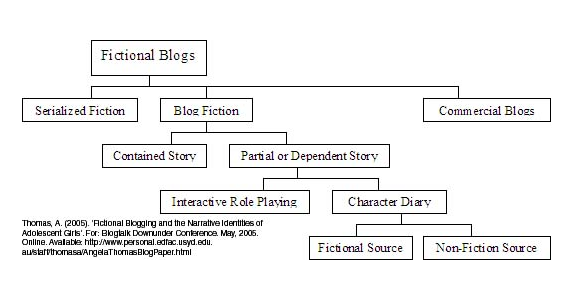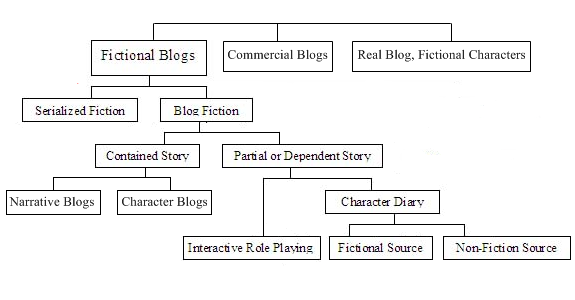We think it's useful to examine the place of blog-novels in the larger scheme of blog fiction, serialized fiction, and online fiction in general. Not because we want to put any author into a pigeonhole or stifle their creativity, but to set up a framework for further discussion.
Our starting point is folks who have looked into this topic from an academic perspective, starting with a 2005 paper by Angela Thomas.

In a blog entry in May of 2005, Betsy Friedrich commented on the terms defined in Thomas's paper:
- Serialized Fiction: Lots of authors have recognized the wonder of the internet as a free publishing tool. These blogs don't necessarily use the blog as a form. Some aren’t even in first person. I suppose someone could blog in the third person, but I think one criteria of blogs is some perceived connection between the narrator/protagonist and the author. It’s great that authors are using blogs to publish their fiction independently, but I think we need to make a distinction between blogs that have fiction in them and fictional blogs.
- Commercial Blogs: This refers to marketing stratgies that utilize blogs. For example, the Captain’s Blog from Captain Morgan's Rum. This is a fictional blog, a blog written by a fictional character, but somehow I feel like intent makes it something different than fictional blogs. The intent here is to sell a product. The story is a by-product of that marketing strategy, rather than the goal itself.
- Contained Story: This is what I think of as a true fictonal blog and deserving of the term. The author has created characters and a world for them. They use the blog as a form, at least to some extent. The blog exists on it’s own, it doesn't rely on any other person's creation to exist.
- Interactive Role Playing: A great grandchild of D&D, in these blogs authors take on a character and maintain that character while interacting with other characters. A fascinating idea, but again, I think it’s more than a fictional blog and the term doesn't do it justice. Maybe they could be called Blog RPGs? Sort of sterile, but at least it’s descriptive.
- Character Diary: In these blogs the author has used a character from an existing work of fiction or from real life and made a blog for that person. For example, Darth Vader's blog. The author found an existing character and is writing a diary for them (which happens to be hilarious, by the by, if you're a Star Wars fan.) Another blogger did his research and wrote a blog as if he were Julius Caeser- another existing "character" that the author liked enough blog as. There are also lots of character diaries surrounding Buffy, the Vampire Slayer and Star Trek. Some character diaries can be really great, but like the other forms, I think they are different than fictional blogs and need their own name.
Friedrich developed her views further in a 2006 thesis and other blog posts such as this one from February 2006:
As I may have said at some point in this blog, I'd like to focus on fictional blogs written in the first person, what I've called a contained story. This is different from people who write fan fiction or short stories which they then publish in blogs. I'm most interested in journals by fictional characters that utilize the format of a blog in some way.
That said, I've been thinking of a second distinction in fictional blogs. There is a difference, I think, between what I call character blogs and narrative blogs. A character blog is heavily based on a fictional character and their daily life. Examples would be God's Blog http://bigoldgod.blogspot.com/, and American Short-Timer americanshort-timer@blogspot.com.
A narrative blog tells a story. It has a beginning and end; there are plot points. It is probably not about the minutia of someone's daily life because that does not make a very interesting story. Examples are Transplanted Life http://transplantedlife.blogspot.com, and Simon of Space http://simonofspace.blogspot.com- the blog I've been reading the most of lately.
I hadn't previously made this distinction, though it seems obvious now- especially since so much between the two is different. The motivations for writing, the process, the readership, all of these are going to depend on whether it is a character blog or narrative blog.
This is our best understanding of Friedrich's circa-2006 typology of blog fiction:

This is a great framework to build on, and future blog-fickers will be indebted to this pioneering analysis. As for our own initial ideas on the subject, we humbly offer a few small revisions.
- First, we're expanding the chart upward to show it in a greater context of online storytelling. Blog fiction is online storytelling that uses a blogging platform, possibly including multimedia elements, hyperlinks, and a commenting system. Other ways to tell a story online include podcasting, webcomics, and forums.
- Second, we're trying to find a better home on the chart for the commercial fiction category, if it even needs to be culled out at all. We disagree with the principle of mixing story content or author intent into the discussion of story format. It would be like saying a movie isn't really a movie if it includes product placements, which many of them do. Or that a book like The Devil Wears Prada isn't really a book because there's a product name in the title. And if we start by excluding commercial fiction, we might also exclude stories that support a political viewpoint, or ones that have a moral lesson, or ones that make us think about philosophical issues, and pretty soon all that's left is bland and mindless. We're keeping the "Commercial Fiction" box on the chart for now, but we're not happy about it.
- Third, we're making a distinction between narrative blogs that unfold in real time and those that don't. We think there's a major difference between how readers interact with these stories and we're also a little biased because our story is one of those real-time types.
So this is where we were in July of 2008:

Additional discussion since then has revolved around where blog-novels, as we like to call them, fit into the chart.
The original consensus of our group was that the real-time element was required, putting them into that bottom left box. Subsequently we've come across some asynchronous blog-novels that work very well in their time frame (and we've taken to calling them "asynchronous" instead of "non-real time" because it's less contrived and more cool sounding that way).
Blog-novels are now synonymous with narrative blogs.
We've added fraud blogs onto the chart, to indicate blogs that present themselves as factual but are really works of fiction. There have been a number of these that have become popular and celebrated, only to have readers throw a fit when they discover that the author is not actually dying of cancer, working as a call-girl, or whatever. It's the same problem we've seen with memoirs that turn out to be fictional or highly embellished--people don't like it when their fact and fiction mix without adequate warning.
Interactive Role Playing is now known as Role Playing Blogs, or RPBs, on our chart--a slight improvement though I'm sure the people who do them probably have a name that's cooler and more descriptive.
Also gone are Character Diaries from Fictional and Non-Fictional Sources. If they're fictional, we're calling them Derived Blogs. If they're non-fictional, we're calling them Fake Blogs--like the Fake Blog of Steve Jobs or the Fake Blog of Dick Cheney.

We'll continue to add to the discussion draft until we come up with more ideas, which we probably will.


No comments:
Post a Comment